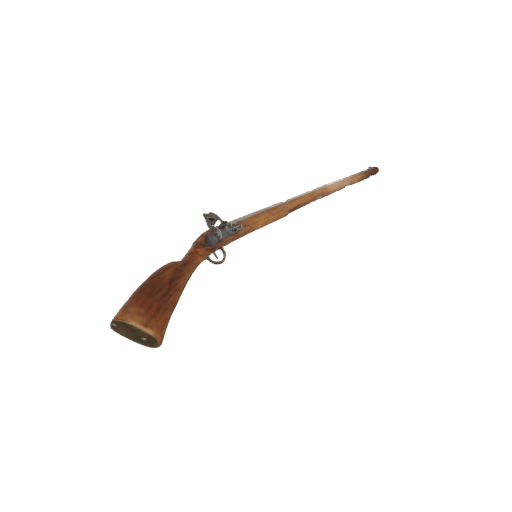Flintlock musket
The Tulle flintlock musket, a 1.5-meter-long gun made of wood and metal, makes its appearance in New France at the end of the 17th century. In 1691, the King of France orders a shipment of approximately 600 muskets for the soldiers of the Navy troops stationed in Canada. This firearm got its name from the company that produced it, the Manufacture royale de Tulle (a town in the Limousin region of France).
Over the following years, the Tulle factory produces approximately the same number of muskets for the colony, some trading firearms intended for commerce with the Indigenous peoples. In the purchase contracts made by the King, there is this mention: “fine hunting muskets for the Savage Chiefs”. These guns are specifically intended for the Indigenous peoples’ leaders as gifts to tie them to French interests.
The Tulle musket consists of three main parts: the stock, to support the musket on the shoulder; the “flintlock” which contains the firing mechanism (lock) to ignite the gunpowder; and the barrel, through which the projectile—a lead bullet—is propelled. Inside the lock, a piece of flint, held by the hammer, produces the spark needed to ignite the powder by striking a steel plate.
European products such as weapons, which were traded for furs, transformed the First Nations’ way of life. With the growing demand for furs in Europe, hunting no longer served only to meet the basic needs of the nation, but also became a business. Their lifestyle became mixed.
Furthermore, the introduction of firearms renders wars even more devastating in terms of casualties and injuries. A greater number of weapons unbalance the forces between two rival nations. For instance, the Huron Nation, an ally of the French, is virtually decimated in 1650 by the Haudenosaunee Confederacy, armed by the Dutch as early as 1639. France, for its part, had forbidden the sale of firearms to its Indigenous allies until 1660.
References
Date: 18th century
Origin: North America
Owner: Le poste de traite de Tadoussac.
Sources:
Bouchard, R.-A. (1980). Les fusils de Tulle en Nouvelle-France: 1691–1741 [The Tulle flintlock musket in New France: 1691–1741]. Université du Québec à Chicoutimi. http://classiques.uqac.ca/contemporains/bouchard_russel_aurore/fusils_de_tulle/fusils_de_tulle_NF.pdf
Bouchard, R.-A. (1999). Les armes à feu en Nouvelle-France [Firearms in New France]. Septentrion. http://classiques.uqac.ca/contemporains/bouchard_russel_aurore/Armes_a_feu_Nouvelle-France/Armes_a_feu_Nouvelle-France.pdf
Le Blond, G. (1757). Fusil [Gun]. In J. L. R. D’Alembert, & D. Diderot (Eds.), L’Encyclopédie ou Dictionnaire raisonné des sciences, des arts et des métiers (vol. 7, p. 395b). Retrieved from http://enccre.academie-sciences.fr/encyclopedie/article/v7–517–0/?query=fusil
Le Blond, G. (1757). Arquebuse [Arquebus]. In J. L. R. D’Alembert, & D. Diderot (Eds.), L’Encyclopédie ou Dictionnaire raisonné des sciences, des arts et des métiers (vol. 1, p. 702b). Retrieved from http://enccre.academie-sciences.fr/encyclopedie/article/v1–3001–0/?query=arquebuse
Mousquet [Musket]. (1765). J. L. R. D’Alembert, & D. Diderot (Eds.), L’Encyclopédie ou Dictionnaire raisonné des sciences, des arts et des métiers (vol. 10, p. 821b). Retrieved from http://enccre.academie-sciences.fr/encyclopedie/article/v10–2142–0/?query=mousquet
Canadian Museum of History. (n.d.). Economic activities: Fur trade. Virtual museum of New France. Retrieved October 6, 2022, from https://www.historymuseum.ca/virtual-museum-of-new-france/economic-activities/fur-trade/
